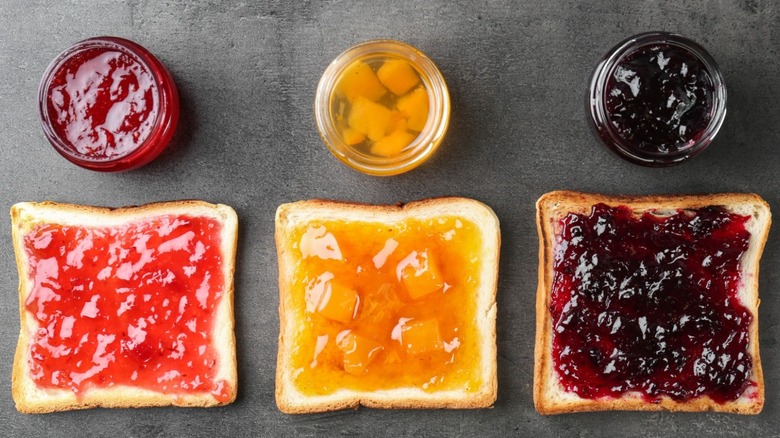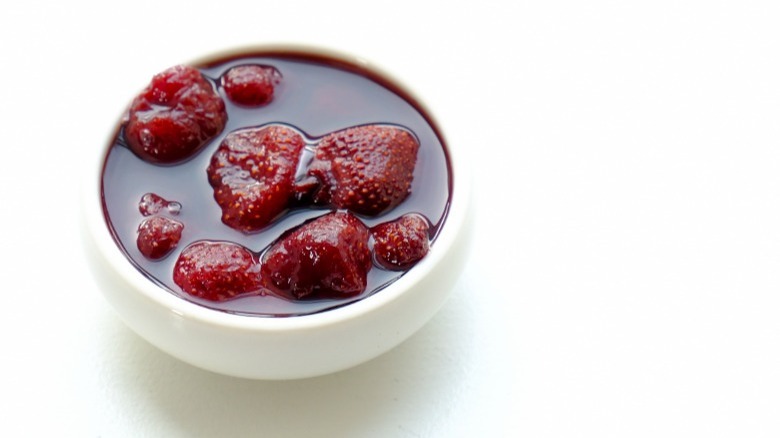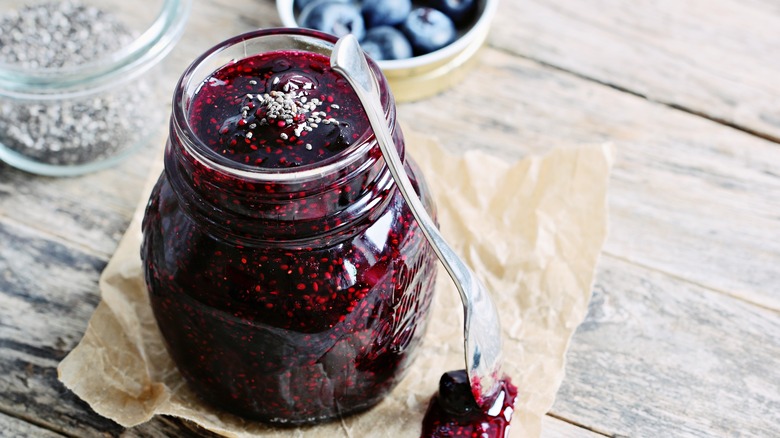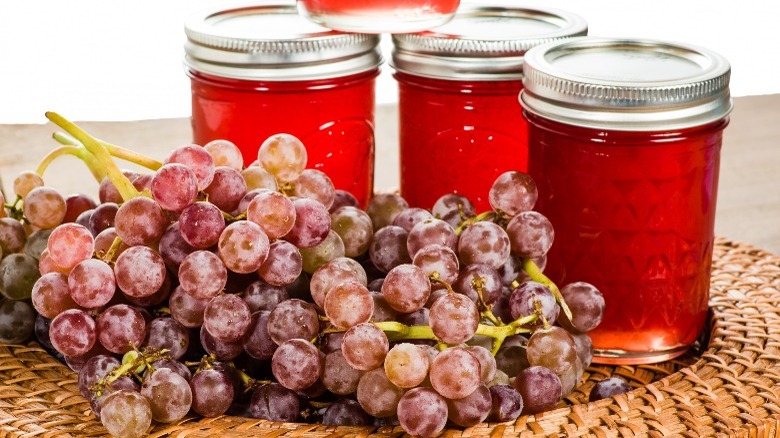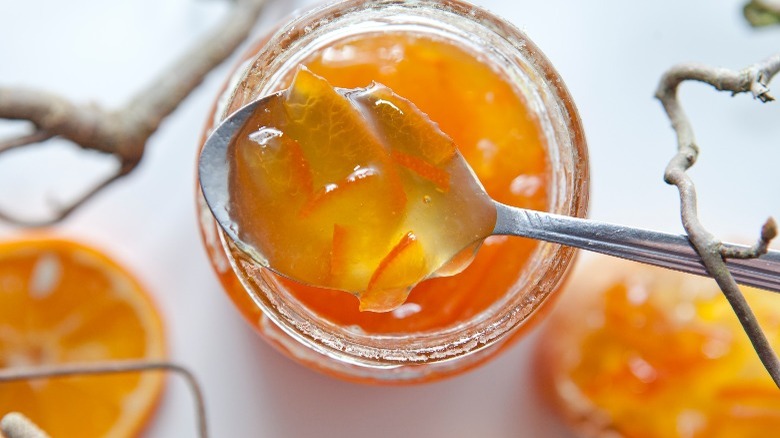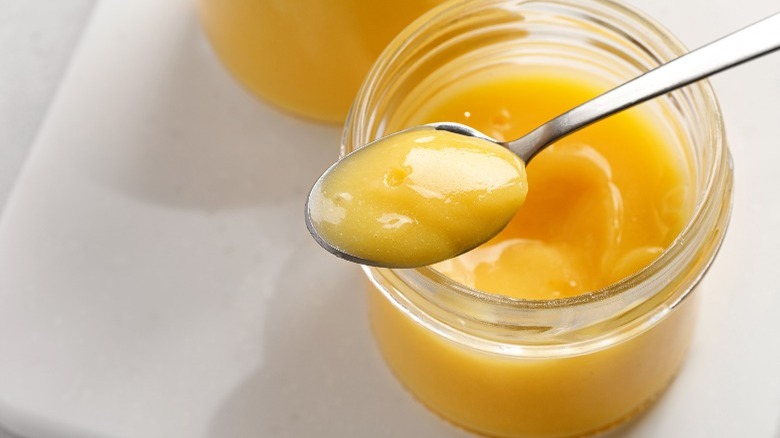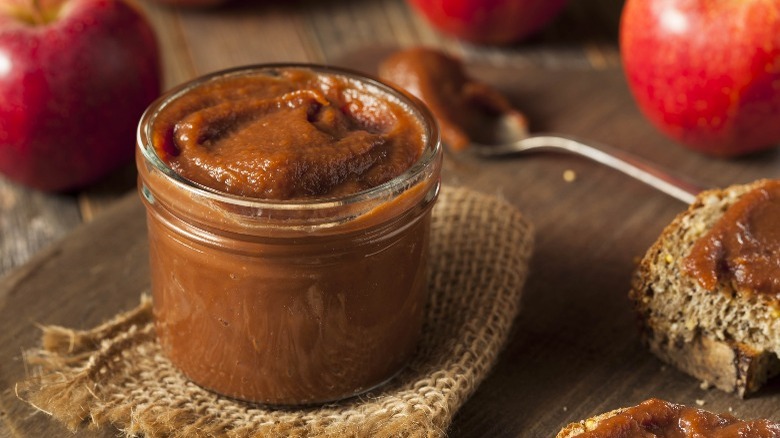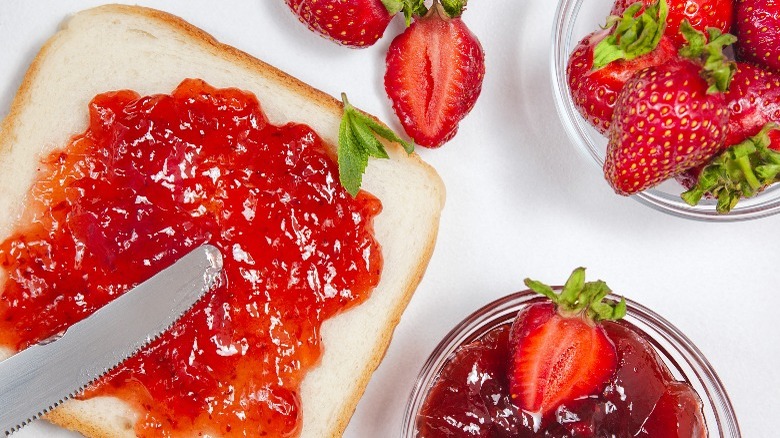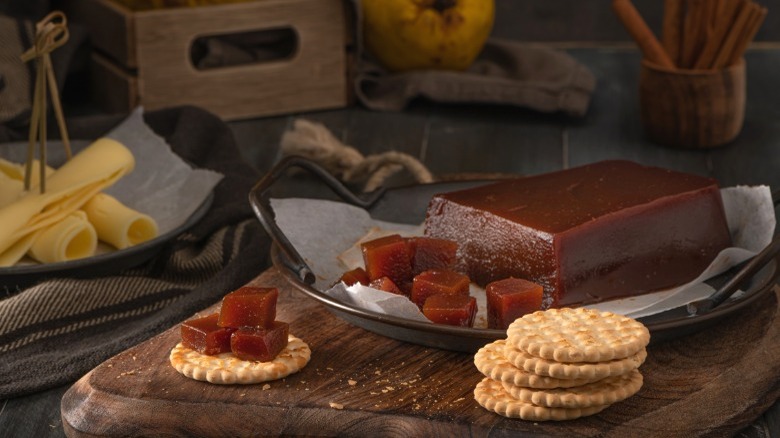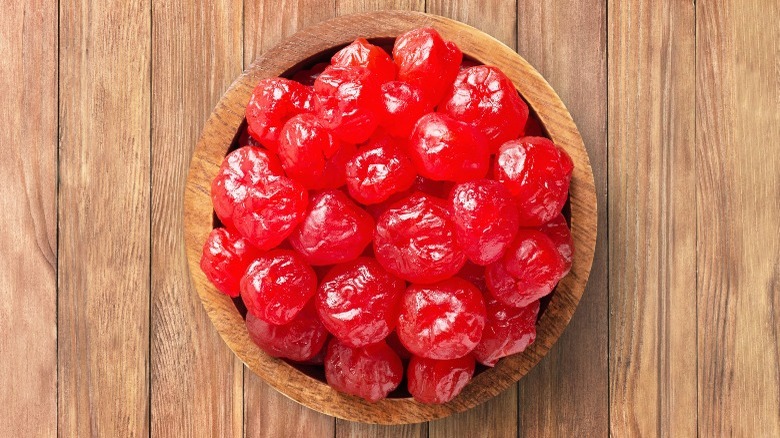9 Types Of Fruit Preserves, Explained
We may receive a commission on purchases made from links.
Once a sign of affluence and an important delicacy throughout 20th-century wars, fruit preserves are now widely available and seem like a basic, if not a little underwhelming, addition to the breakfast table. But they have a long history and fascinating chemistry that made them indispensable companions to humans throughout the ages.
Today, there is an evident spike in the jam and jelly market influenced by the COVID-19 pandemic and the subsequent need to rely on convenience foods with longer shelf lives, whether store-bought or homemade (via Mordor Intelligence). In addition, the rise of home cooking brings DIY canning to the forefront, considering its ability to evoke a feeling of nostalgia and a sense of community (via Environmental Communication). All of this suggests that there's more to preserves than we thought.
Not only is it important to recognize their cultural role, but it's also crucial to understand the basic chemistry of fruit preserves before we get into specifics. What do all of them have in common? They are generally made with some combination of sugar, pectin, and acid. Keeping this in mind, let's dive into the sweet world of fruit preserves.
1. Fruit preserves
"Fruit preserve" is both the umbrella term for fruit spreads and a particular variety of them. Making one requires cooking whole fruit (or solid chunks) in sweet syrup. It is one of the trickier varieties to make at home since it requires skill and knowledge to tell how much heat fruit can take before it overcooks and loses its shape or dissolves. The best options for these preserves are those low on pectin or would be easier to keep whole without processing. For example, ripe cherries would be perfect, as they are low-pectin fruits that require pitting, which you can skip for this process.
Compotes are sometimes mistaken for this type of preserve, as they are also composed of whole fruit cooked in sugar syrup. The difference is that they are cooked quickly and meant to be consumed shortly after being prepared. Preserves, on the other hand, have always been made to last. For example, in Eastern Europe — where fruit supply was low, and winters were long and brutal — a preserve known as "varenye" quite literally saved lives in times of food scarcity thanks to its long shelf life (via "Jam, Jelly and Marmalade: A Global History"). Preserves are best enjoyed on their own as a tea-time treat, but you could also use them as a pastry filling and an oatmeal or ice cream topping.
2. Jam
When you hear "fruit preserve," jam is probably the first thing that comes to mind. But this hasn't always been the sweet and spreadable breakfast treat we know today. Some suggest that the credit for jam creation belongs to Sasanian Persia, where pectin-rich fruits were aplenty, and sugar was already cultivated by the 6th century CE (via "Jam, Jelly and Marmalade: A Global History"). Today, it is made with finely chopped-up or crushed fruit cooked down in sugar until it reaches the desired consistency and is left to set. Jams are one of the lower-effort kinds of preserves, so they would be a great place to start if you're looking to get into the home canning game.
There are other types of fruit preserves that fall into this category. For example, conserve is a kind of jam made with two or more kinds of fruit (as well as spices and nuts), resulting in an often chunky delicacy. More recent inventions are the no-cook "freezer jams," made from fresh or frozen berries and extra pectin, and chia seed jams, which require no additional pectin or sugar because the chia seeds help it thicken. Regardless of the method you choose, you'll end up with a versatile creation that is perfect for adding to any dish that requires a burst of fruit or berry flavor.
3. Jelly
Known for its clear composition and spreadable consistency, jelly is the refined beauty of the fruit preserves family. The cooking process is similar to that of jams, with the added steps of straining the fruit pulp (traditionally, with the help of time and a jelly bag to produce the best results) and boiling down the leftover juice. Additional pectin is often required to help the mixture set. This results in a clear and smooth concoction with no solid bits. The seamless, uniform consistency of jelly is likely why it became half of the iconic sandwich duo alongside peanut butter. Still, it works just as well on a cracker or a bagel paired with cream cheese or sandwiched between cookies.
Today, the homogenous texture and bright fruit flavor make jellies popular with kids and adults alike. But they were also once valued for their aesthetic qualities. In the wealthy homes of Georgian-era England, they were served in glasses rather than on plates and often arranged in elegant yet eye-catching formations illuminated by candlelight. So, in addition to being a dessert, they added to the overall atmosphere of the pre-electricity dining rooms (via "Jam, Jelly and Marmalade: A Global History").
4. Marmalade
A citrus-heavy concoction, marmalades are a relatively recent addition to the ancient fruit preservation tradition. Making the first commercially produced orange variety that led to the delicacy we know today is credited to Janet Keiller, a wife of a Scottish grocer. Even though this marmalade was already famous in and outside of Scotland towards the end of the 18th century, she was the one to popularize adding shredded orange peels ("chips") into the recipe over the existing, more laborious tradition of beaten marmalade (via "The Book of Marmalade"). Since then, it has only risen in popularity throughout Britain, earning the likes of Queen Elizabeth II and her fans.
While marmalades could be attributed to the jam family, considering the similar cooking process and the use of crushed fruit, unlike jams, they are predominantly made from citrus fruits and have a crumblier, drier consistency. Adding the pectin-rich peels contributes to the gelling process and adds an extra layer of texture, which works well on warm morning toast or a fluffy, well-buttered scone.
5. Fruit curd
Fruit curd is a rich, glossy spread that stands out in the fruit preserve family. The most famous flavor is lemon, which is considered a staple of British cuisine. Once known as "lemon cheese," this creamy preserve is made by heating up the zest and juice of lemons with butter and sugar until everything melts together, then adding eggs which provide the signature yellow tint, density, and glossiness. The mixture then thickens to a spreadable consistency over gentle heat. Once done, it needs to be thoroughly chilled and served cold. This delectable, buttery preserve can elevate many recipes. It can be spread between cake layers, used as a tart filling, drizzled over waffles, or even enjoyed straight out of the jar.
Even though lemon is the classic flavor, other variations, from berries to watermelon and even passionfruit curd, are possible. Aim for juicy fruit varieties, and your curd experiments won't fall flat. Also, considering it's the only kind of preserve relying on animal-derived ingredients in the present day, it needs to be vegan for those adhering to a plant-based diet. Luckily, this has successfully been done by food bloggers through the use of non-dairy milk or butter, turmeric, and starch, so you can easily recreate the familiar texture and flavor without animal products.
6. Fruit butter
To the joy of those with dairy allergies, fruit butter doesn't actually contain butter. In fact, it is a fruit puree that has been boiled down to a thicker, more spreadable consistency that won't leave your toast soggy. The cooking process is slow but effective: prolonged exposure to gentle, consistent heat causes the fruit's natural moisture to evaporate and breaks them down regardless of its pectin content while also requiring less added sugar. The result is not as sweet as other preserves but offers a deeper fruit flavor.
Even though making your own fruit butter takes longer than other preserves, the process is relatively easy, and the result is worth it. The fruit butter of yore required almost the undivided attention of those who made them, but today, a slow cooker is a vehicle that will get you there fuss-free. If you ever feel like making peach butter from scratch, all you'll need to do is load the fruit, sugar, and spices into this handy machine, stir every few hours, then puree the result with a blender until it's perfectly creamy. Spread your homemade fruit butter on toast, mix it into a bowl of oatmeal, or make it a base for your dairy-free butter board.
7. Fruit spread
You might think any fruit preserve with a spreadable consistency could be called a fruit spread. And while that might be true colloquially, legally, fruit spreads are their own separate category. Fruit butter, jams, and jellies all require sugar or another "nutritive carbohydrate sweetener" to be on the ingredient list (via National Archives Code of Federal Regulations). The latter are sugars and sugar alcohols that add calories to products. Meanwhile, fruit spreads are the kind of preserve made without any sugar and offer the most natural fruit flavor — and isn't that what we want from a fruit preserve in the first place?
That isn't to say that there's no sugar in fruit spreads. First, there are natural sugars in the produce. The spreads are often made with pectin-heavy fruit like apples or apricots that don't require additional sugar to gel, and the homemade versions also rely on chia seeds to help the low-pectin fruit to gel. The commercial "sugar-free" preserves could also be prepared with other natural and artificial sweeteners, like stevia or Splenda. So if you're trying to lower your sugar intake, natural fruit spreads are the way to go. Alternatively, if you'd like to enjoy them with something sweet, substitute them for jam or jelly in baking recipes, which typically have plenty of sugar on the ingredient list.
8. Fruit cheese
Like fruit butter, fruit cheese gets its name due to its similarity to its dairy counterpart, yet it doesn't have a single drop of dairy. Unlike the spreadable jams and jellies, it has a solid yet tender, sliceable consistency. This is made by softening the fruit, running them through a sieve, and cooking the resulting puree down with sugar until it sets. The sugar-to-fruit ratio commonly used is 1:1.
One historically significant example of fruit cheese is quince cheese, a thick jelly from the Mediterranean basin. Roman agriculturist and writer Palladius described a dish resembling modern fruit cheese around the 4th century CE. He suggested cooking down quince shreds with honey until it reduced in half, producing a thick paste (via "On Food and Cooking: The Science and Lore of the Kitchen"). A little over ten centuries later, it has gained traction in Spain and Portugal (where it was known as dulce de membrillo and marmelada, respectively) and spread across the world (via Atlas Obscura). Today, regional varieties of fruit cheese can be found anywhere from Brazil and Uruguay to Serbia and Hungary. It is often enjoyed on its own or paired with crackers or other cheeses.
9. Candied fruit
Crystallized, candied, glacé, and confit fruit all refer to the same kind of preserve. This can be confusing, considering there is a cooking method called confit and a kind of fruit preserve named confiture. Both terms come from the French verb "confire," meaning "to preserve." While "confiture" refers to any fruit cooked with a thick syrup, "confit" is often understood as a meat dish, slow-cooked and preserved in oil or other fat.
However, the confit cooking method can be applied to almost anything, including fruits and vegetables. In the case of fruit confit, fat is replaced by sweet syrup. Ripe whole fruits, their pieces, or peels, are usually cooked on low heat in a saturated sugar syrup that absorbs moisture inside, leading to their preservation. Sometimes the produce is additionally soaked in several changes of syrup. They are then typically drained and dried. Candied fruit is slightly tedious to make at home, but if you ever decide to try it, Ditters lists citrus fruits, pears, apples, plums, peaches, pineapple, and, of course, quinces among the best fruit for candying. Using their leftover peels lowers food waste and makes a delicious snack. Candied fruit can be enjoyed independently, used to decorate other dishes and drinks, or given as gifts.
